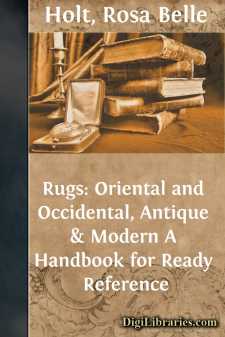Categories
- Antiques & Collectibles 13
- Architecture 36
- Art 48
- Bibles 22
- Biography & Autobiography 813
- Body, Mind & Spirit 142
- Business & Economics 28
- Children's Books 15
- Children's Fiction 12
- Computers 4
- Cooking 94
- Crafts & Hobbies 4
- Drama 346
- Education 46
- Family & Relationships 57
- Fiction 11829
- Games 19
- Gardening 17
- Health & Fitness 34
- History 1377
- House & Home 1
- Humor 147
- Juvenile Fiction 1873
- Juvenile Nonfiction 202
- Language Arts & Disciplines 88
- Law 16
- Literary Collections 686
- Literary Criticism 179
- Mathematics 13
- Medical 41
- Music 40
- Nature 179
- Non-Classifiable 1768
- Performing Arts 7
- Periodicals 1453
- Philosophy 64
- Photography 2
- Poetry 896
- Political Science 203
- Psychology 42
- Reference 154
- Religion 513
- Science 126
- Self-Help 84
- Social Science 81
- Sports & Recreation 34
- Study Aids 3
- Technology & Engineering 59
- Transportation 23
- Travel 463
- True Crime 29
Rugs: Oriental and Occidental, Antique & Modern A Handbook for Ready Reference
by: Rosa Belle Holt
Categories:
Description:
Excerpt
The History
Rugs, in the house beautiful, impart richness and represent refinement. Their manufacture was one of the earliest incentives for the blending of colors in such harmony as to please the eye and satisfy the mind; consequently, it is one of the most important of the industrial arts. Since the days when ancient peoples first lay down to sleep wrapped in the skins of animals, the human intelligence has quickened, and as the race has become more civilized, rugs have gradually taken the place of skins. Thus began the industry of rug-weaving, and it has grown to such an extent that it is now of world-wide importance.
The word Rug is used in this volume in the following sense: "A covering for the floor; a mat, usually oblong or square, and woven in one piece. Rugs, especially those of Oriental make, often show rich designs and elaborate workmanship, and are hence sometimes used for hangings," In several books rugs and carpets are referred to as identical. In fact most written information on rugs has been catalogued under the term carpets; and there seems to be good reason for assuming that the terms tapestries and carpets, as used in ancient times, were synonymous with the word rugs of the present day, for these were spread loosely on the floor without the aid of fastenings.
Historical references to spinning and to the weaving of tapestries date back to a very early period. An ancient Jewish legend states that Naamah, daughter of Lamech and sister of Tubal-Cain, was the inventor of the spinning of wool and of the weaving of thread into cloth.
On at least two of the wonderful rock-cut tombs at Beni-Hassan, in Egypt,—2800-2600 B.C.,—there are pictures of weavers at work. In one, women are filling a distaff with cotton, twisting it with a spindle into thread, and weaving this on an upright loom. Beside them is a man, evidently an overseer, watching the weavers and their work. The other wall-painting represents a man weaving a checkered rug on a horizontal loom. Other monuments of ancient Egypt and of Mesopotamia bear witness that the manufacture of rugs dates a considerable time prior to 2400 B.C.
At Thebes a fresco, dating 1700-1000 B.C., represents three men weaving at an upright loom. A small rug, discovered in that city some time between the years 666 and 358 B.C., and now in the possession of Mr. Hay in England, is described by Sir J. Gardner Wilkinson as follows: "This rug is eleven inches long by nine broad. It is made like many carpets of the present day, with woollen threads on linen string. In the centre is the figure of a boy in white, with a goose above it, the hieroglyphic of 'child' upon a green ground, around which is a border composed of red, white, and blue lines. The remainder is yellow, with four white figures above and below, and one at each side, with blue outlines and red ornaments; and the outer border is made up of red, white, and blue lines, with a fancy device projecting from it, with a triangular summit, which extends entirely round the edge of the rug....


